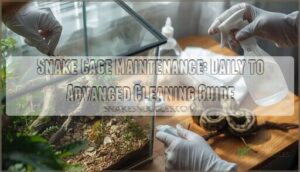This site is supported by our readers. We may earn a commission, at no cost to you, if you purchase through links.
Your ball python hasn’t eaten in three weeks, spends hours soaking in its water bowl, and you’ve noticed tiny specks moving near its eyes. These aren’t quirks of personality—they’re textbook signs of parasitic infection, one of the most common yet misdiagnosed health problems in captive snakes.
Parasites range from visible external mites that drain blood to microscopic protozoans that destroy intestinal tissue, and left untreated, they’ll systematically weaken your snake’s immune system until secondary infections take hold.
Accurate diagnosis requires more than guesswork; you’ll need fecal exams, skin scrapings, and sometimes blood work to identify the specific parasite before treatment can begin.
Once you understand the diagnostic process and treatment protocols for ectoparasites, endoparasites, and protozoans, you can address infections promptly and prevent the cascading health problems that follow.
Table Of Contents
- Key Takeaways
- Common Parasitic Infections in Snakes
- Recognizing Symptoms of Parasitic Infections
- Diagnosing Parasitic Infections in Snakes
- Step-by-Step Treatment of Snake Parasites
- Preventing Future Parasitic Infections
- Frequently Asked Questions (FAQs)
- What is the best treatment for a parasitic infection?
- How to fix a parasitic infection?
- How to treat a parasite infection at home?
- How can parasitic infections be controlled?
- What medicine treats parasites in reptiles?
- How to tell if your snake has parasites?
- How do you treat snake nematodes?
- How do you treat cryptosporidium in snakes?
- What environmental factors contribute to snake parasitic infections?
- How often should a snake be checked for parasites?
- Conclusion
Key Takeaways
- Parasitic infections in snakes fall into three main categories—ectoparasites like mites and ticks, endoparasites including nematodes and cestodes, and protozoal organisms like Cryptosporidium—each requiring specific diagnostic methods and targeted antiparasitic medications prescribed by a veterinarian.
- Accurate diagnosis demands fecal exams using flotation and sedimentation techniques, skin scrapings for mite identification, and sometimes blood tests or imaging to detect systemic parasites, since visual symptoms alone won’t reveal the specific organism causing infection.
- Treatment protocols combine targeted medications—fenbendazole for intestinal worms, ivermectin for mites, metronidazole for protozoal infections—with rigorous environmental disinfection using bleach or reptile-safe products applied every 3-5 days for three weeks to eliminate reinfection cycles.
- Prevention through 60-90 day quarantine periods with repeated fecal testing, daily enclosure cleaning, frozen feeder prey held for 30 days, and biannual veterinary check-ups stops parasitic infections before they establish and prevents the weight loss, anemia, and systemic disease that follow untreated infestations.
Common Parasitic Infections in Snakes
Parasitic infections represent a significant health concern in captive and wild snake populations, affecting multiple organ systems and compromising overall physiological function.
Early detection through regular health monitoring helps prevent complications, especially since recognizing common signs of snake diseases allows keepers to intervene before parasitic loads become life-threatening.
Your snake may encounter external parasites that attach to the skin, internal parasites residing in the gastrointestinal tract, or microscopic protozoal organisms that infiltrate tissues.
Regular vet checkups and proper hygiene are your best defense—find detailed prevention strategies in our guide on recognizing and preventing snake parasites.
Understanding the distinct categories of parasites allows you to recognize clinical signs early and pursue appropriate diagnostic procedures.
From preventative husbandry practices to targeted treatments, effective reptile parasite control methods can help you address infestations before they escalate into serious health complications.
Ectoparasites—Mites and Ticks
Ectoparasites—mites and ticks—represent the most frequently encountered external parasites in captive snakes. Mite identification requires careful examination of the snake’s scales for small, dark oval bodies, particularly in skin folds and around the eyes. Tick removal demands precision to avoid leaving mouthparts embedded in tissue.
Key identification features include:
- Small pearly to dark oval mites attached to scales causing rubbing and shedding abnormalities
- Hard-bodied ticks lodged in crevices between scales or around the cloaca
- Local skin irritation and tissue damage at attachment sites
- Behavioral changes including increased scratching against enclosure surfaces
Accurate reptile parasitology assessment guides appropriate ectoparasite control and parasite prevention through targeted treatment protocols and enhanced snake hygiene practices.
Endoparasites—Nematodes, Cestodes, Trematodes
Internal helminths—nematodes, cestodes, and trematodes—invade your snake’s gastrointestinal tract, liver, or other organs. Nematode infections commonly produce reduced weight gain and intermittent diarrhea correlated with parasite load. Cestode diagnosis requires fecal examination revealing characteristic eggs or proglottids. Trematode treatment targets liver or intestinal flukes using specific anthelmintics.
Regular endoparasite monitoring through fecal microscopy quantifies egg counts, guiding helminth control and effective parasite control measures within thorough reptile parasitology protocols.
Protozoal Parasites—Cryptosporidium, Entamoeba
Beyond helminths, protozoal infections—especially cryptosporidiosis and Entamoeba invadens—present diagnostic challenges in snake immunity assessment and parasitology.
Cryptosporidium serpentis causes chronic gastritis with postprandial regurgitation; oocysts require specialized fecal concentration and acid-fast staining. Entamoeba invadens produces hemorrhagic enteritis and hepatic necrosis.
Treatment efficacy varies substantially, necessitating molecular diagnostics and strict parasite control measures to interrupt protozoal disease transmission within reptile collections.
Pentastomes and Less Common Parasites
While protozoans get attention, pentastome infections—caused by crustacean-like parasites—challenge reptile parasitology with cryptic respiratory and visceral presentations. Linguatula and Armillifer species infect snake hosts through rodent ingestion, producing dyspnea and nonspecific weight loss. Diagnostic challenges include poor fecal test sensitivity and reliance on imaging or necropsy. Treatment options remain limited, requiring species-specific protocols and strict biosecurity to manage parasite life cycles and potential zoonotic risk.
Bacterial co-infections often complicate pentastomiasis cases, so veterinarians may explore proven snake bacterial infection treatments alongside antiparasitic strategies to stabilize respiratory function.
- Pentastomes commonly localize in lungs, causing granulomatous lesions you can’t see externally
- Rodent-based intermediate hosts drive regional infection patterns in captive collections
- Imaging reveals characteristic nodular masses consistent with chronic pentastome colonization
Recognizing Symptoms of Parasitic Infections
You must learn to identify the clinical signs of parasitic infection before treatment becomes urgent.
Parasitized snakes exhibit a combination of physical deterioration, behavioral abnormalities, and visible evidence of infestation. Your recognition of these symptoms determines whether intervention succeeds or the infection progresses to systemic disease.
Physical Signs—Weight Loss, Lethargy
Your snake’s gradual loss of body condition and persistent sluggishness aren’t just signs of poor husbandry—they’re often the first visible indicators that parasites have established infection within your animal’s system. Regular checks for reptile parasite infections can help identify issues early on.
Weight loss occurs as intestinal parasites compete for nutrients, compromising your snake’s metabolic processes. Lethargy signs manifest when parasitic loads burden the immune system, reducing activity levels and thermoregulatory behavior.
Early detection through regular health checks and proper snake care practices can help you identify parasitic infections before they cause severe weight loss or lethargy.
Behavioral Changes—Reduced Appetite, Hiding
Frequently, parasitic infections trigger anorexia signs and withdrawal—changes that separate pathological causes from routine shedding-related fasting. When your snake refuses prey beyond normal species fasting patterns and spends excessive time in hides, parasitology demands investigation.
Environmental impact and stress factors complicate diagnosis, but persistent appetite loss paired with reclusive behavior warrants fecal examination to rule out gastrointestinal helminths, protozoans, and conditions like inclusion body disease affecting snake care and reptile health. Understanding snake health issues is vital for effective diagnosis and treatment.
Visible Parasites—Mites on Skin and Eyes
Ophionyssus natricis appears as tiny black, grey, or red specks crawling on your snake’s body—direct evidence of mite infestations demanding immediate parasite control. These ectoparasites cluster visibly around the eyes, nostrils, chin folds, vent, and ventral scales, causing skin irritation and predisposing to secondary skin infections that compromise reptile health.
Heavy parasitic burdens produce observable mite dust on shed skin and enclosure surfaces, while your snake exhibits prolonged soaking attempts to drown parasites—behavioral indicators requiring urgent mite eradication protocols to prevent anemia, dermatitis, and potential transmission of systemic pathogens, including inclusion body disease vectors.
| Location | Visual Signs | Associated Symptoms |
|---|---|---|
| Eyes and periocular scales | Small moving black dots, swollen scales | Retained eye caps, rubbing behavior, eye infections |
| Chin and neck folds | Clustered grey or red specks | Restlessness, increased rubbing |
| Vent and ventral scales | Mites buried under scales | Prolonged soaking, anorexia |
| Water bowl | Floating dead mites, white debris | Lethargy, skin damage |
| Shed skin and surfaces | Black dots, mite dust | Visible reinfestation risk |
Fecal Abnormalities—Diarrhea, Blood
Abnormal fecal presentation often signals internal parasitic infections requiring immediate fecal analysis for definitive parasite detection. Diarrhea causes in reptiles include intestinal parasites—nematodes, Cryptosporidiosis, and Coccidiosis—while hematochezia indicates mucosal damage from protozoal diseases compromising intestinal health.
- Mucoid or watery diarrhea suggests Cryptosporidium or Entamoeba invadens
- Bloody stools indicate coccidial infections or severe helminth burdens
- Chronic loose feces with weight loss points to parasitic infections requiring microscopy
Diagnosing Parasitic Infections in Snakes
Accurate diagnosis requires specific diagnostic techniques that identify the type and severity of parasitic infection affecting your snake. Your veterinarian will select appropriate tests based on clinical signs, parasite location, and suspected organisms.
The following diagnostic methods provide the foundation for targeted treatment protocols.
Fecal Exams and Microscopy
Fecal examination is your most reliable method for diagnosing intestinal parasites, protozoal diseases such as cryptosporidiosis and coccidiosis, and other hidden infections. Fresh samples, ideally 1 to 2 grams, are submitted for diagnostic protocols that combine flotation methods and direct smears. This approach effectively detects nematode eggs, coccidian oocysts, and motile flagellates with precision.
Microscopy techniques at 100× and 400× magnification enable parasite identification based on size, morphology, and structural features. Veterinarians use calibrated equipment to measure oocysts and differentiate taxa, ensuring accurate diagnosis.
| Technique | Target Parasites | Key Advantage |
|---|---|---|
| Flotation (specific gravity 1.3) | Nematode eggs, coccidian oocysts | Floats lighter stages efficiently |
| Sedimentation | Heavy trematode eggs, some larvae | Recovers parasites that don’t float |
| Direct saline smear | Motile protozoa, flagellates | Visualizes live trophozoites |
| Iodine-stained smear | Protozoal cysts, oocysts | Enhances internal structures |
| Acid-fast stain | Cryptosporidium, acid-fast coccidia | Identifies small, cryptic oocysts |
Skin Scrapings and Mite Identification
When ectoparasites burrow beneath your snake’s scales, standard visual inspection often fails. Skin scraping using a number 10 scalpel blade held perpendicular to the epidermis collects debris for microscopic exam.
You’ll identify Ophionyssus natricis—the hematophagous snake mite—by its oval body, dark blood-filled gut, and characteristic leg arrangement at 100× magnification, confirming ectoparasite control needs.
Blood Tests for Systemic Parasites
While surface parasites reveal themselves under the microscope, systemic invaders—like filarial nematodes and hemogregarines—circulate silently in your snake’s bloodstream, requiring hematological analysis for detection.
Blood smears stained with Wright-Giemsa reveal:
- Intraerythrocytic parasites indicating hemoparasitism
- Microfilariae confirming filarial nematode burden
- Elevated leukocyte counts suggesting parasitic inflammation
Serum analysis and diagnostic markers quantify parasite load, guiding veterinary treatment options for reptile health management and zoonotic disease prevention through parasite control and treatment protocols.
Imaging for Internal Parasites
Radiographic techniques visualize pulmonary pentastomids as soft-tissue opaque structures within snake lungs, though lateral views surpass dorsoventral projections in diagnostic imaging clarity.
Ultrasonography detects echogenic parasites in coelomic organs, facilitating targeted sampling for definitive parasite detection.
Computed tomography provides enhanced spatial resolution for reptile health management, revealing granulomatous lesions missed on standard radiographs.
These veterinary treatment options complement fecal diagnostics in thorough parasite control and treatment protocols within reptile medicine.
Step-by-Step Treatment of Snake Parasites
Treatment protocols for parasitic infections in snakes must address both the organism and environmental factors that allowed colonization. Your veterinarian will determine the appropriate medication based on fecal analysis, microscopy findings, and clinical presentation.
The following sections outline specific treatment approaches for ectoparasites, endoparasites, protozoal infections, environmental management, and follow-up monitoring protocols.
Treating Ectoparasites—Sprays, Dips, Ivermectin
Your veterinarian can approach ectoparasite management through several pathways. For mites and ticks, you’ll likely encounter:
- Ivermectin at 200 mcg/kg subcutaneously every 14 days (contraindicated in chelonians)
- Fipronil spray wiped on, rinsed after 5 minutes, repeated weekly
- Permethrin dust (0.25%) applied to substrate and surfaces
- Systemic isoxazolines like afoxolaner at 2.5 mg/kg orally for sustained mite control
Topical therapies require precise dosing and veterinary supervision.
Deworming Medications for Intestinal Parasites
Once you’ve addressed external parasites, your veterinarian will shift focus to internal helminths through targeted antiparasitic agents that eliminate nematodes, cestodes, and trematodes from your snake’s gastrointestinal tract.
Fenbendazole at 50–100 mg/kg orally or praziquantel at 8 mg/kg for cestodes represent standard protocols.
Treatment duration usually spans 3–5 days, with fecal recheck at 2–4 weeks to assess efficacy and detect parasite resistance.
Medications for Protozoal Infections
Protozoal diseases like Entamoeba invadens and Cryptosporidium serpentis demand targeted antiprotozoal drugs under veterinary supervision. Metronidazole therapy at 20–50 mg/kg orally every 24–48 hours clears Entamoeba in 90% of cases, supporting effective protozoal management.
For cryptosporidiosis treatment, hyperimmune colostrum administered weekly via gastric intubation reduces oocyst shedding and gastric lesions, though no standard chemotherapeutic eliminates this parasite consistently in reptile care and management.
Environmental Cleaning and Disinfection
Beyond treating your snake, thorough enclosure sanitizing breaks the parasite’s life cycle and prevents secondary conditions like septicemia. Reptile care and management demands strict biosecurity measures, combining mechanical cleaning with disinfectant selection approved for veterinary medicine:
- Remove and discard all substrate, porous hides, and contaminated décor outside your home.
- Scrub empty enclosures with hot water above 50°C and dish detergent to dislodge debris.
- Apply diluted chlorine bleach (1:10–1:30) or reptile-safe disinfectant following manufacturer protocols for mite removal.
- Spray walls and crevices with 0.15% trichlorfon or 1% permethrin, allowing 24–48 hours drying time.
- Repeat cleaning protocols every 3–5 days for three weeks to target emerging larvae.
Proper animal husbandry requires air-drying enclosures completely before reintroduction, preventing respiratory irritation and microbial growth while reducing inclusion body disease transmission risk through rigorous cleaning protocols.
Monitoring and Follow-Up Care
Post-treatment monitoring requires systematic fecal analysis techniques every two weeks to confirm parasite eradication methods succeeded. You’ll need three consecutive-day samples processed promptly, as single negative results don’t exclude residual infection—immature stages shed sporadically.
Ongoing care strategies include weekly body weight tracking, fluid therapy at 15–25 ml/kg/day for debilitated animals, and veterinary care for reptiles incorporating routine health checks even when pet snake care appears normal. Maintaining snake health and wellness through reptile care and maintenance protocols helps catch subclinical parasitoses early.
| Monitoring Parameter | Recommended Frequency |
|---|---|
| Fecal examination | Every 2 weeks, 3 consecutive samples |
| Body weight assessment | Weekly during recovery |
| Veterinary health checks | Routine intervals post-treatment |
Preventing Future Parasitic Infections
Prevention is always more effective than treatment when managing parasitic infections in captive snakes. You can greatly reduce your snake’s risk of infection through consistent husbandry practices, careful quarantine protocols, and regular veterinary monitoring.
Prevention through consistent husbandry, quarantine, and veterinary monitoring reduces parasitic infection risk far more effectively than treatment alone
The following strategies will help you establish a thorough prevention program that tackles both environmental and biological risk factors.
Quarantine and Health Screening
Quarantine protocols act as your first line of defense against introducing parasites into your established collection. When you bring home a new snake, isolate it for 60–90 days and arrange a veterinary health check within the first two weeks to screen for both external and internal parasites through fecal exams, skin scrapings, and blood tests.
- House quarantined snakes in a separate room with dedicated equipment—feeding tongs, water dishes, and cleaning tools—that never touch your main collection
- Use disposable paper towel substrate and minimal furnishings so you can spot mites, ticks, or abnormal feces immediately during daily inspections
- Handle quarantined animals last in your routine and wash your hands thoroughly after contact to prevent mechanical transfer of pathogens
Biosecurity measures during this period include repeated fecal testing at intervals, since some intestinal parasites shed eggs intermittently, and maintaining a detailed log of observations, test results, and treatments. This structured approach to captive reptile care and animal health and wellness ensures you detect subclinical infections before they spread, giving you control over your collection’s long-term health.
Proper Enclosure Hygiene
Daily cleaning of your snake’s enclosure removes feces, shed skin, and uneaten food that harbor parasite eggs, protozoal oocysts, and bacteria responsible for skin infections, dermatitis, respiratory disease, and septicemia.
Replace water dishes daily, disinfect all surfaces with reptile-safe products like F10SC or diluted bleach every two to four weeks, and maintain strict biosecurity measures by using separate equipment for each enclosure to prevent cross-contamination and inclusion body disease transmission.
Safe Feeding Practices
You break the transmission cycle by sourcing feeder rodents from reputable commercial breeders rather than wild-caught prey carrying intestinal nematodes, cestodes, mites, ticks, pentastomes, and leeches.
Freeze prey for at least 30 days to kill parasites, then thaw it in a refrigerator before warming to 100 degrees Fahrenheit, maintaining food safety while delivering proper snake nutrition and feeder quality.
Routine Veterinary Check-Ups
Even with spotless husbandry and frozen prey, schedule wellness examinations every six to twelve months. Your reptile veterinarian will perform fecal microscopy to detect gastrointestinal parasites, inspect ventral scales and spectacles for mites, establish baseline body weight, and build a medical history that facilitates early diagnosis of subclinical infections you won’t catch at home.
Frequently Asked Questions (FAQs)
What is the best treatment for a parasitic infection?
Treatment depends on accurate parasite identification through fecal examination or skin scraping.
Fenbendazole effectively eliminates nematodes, metronidazole targets protozoal infections like Entamoeba, while acaricides control mites—each requiring veterinary guidance for proper dosing and infection control.
How to fix a parasitic infection?
Your veterinarian will prescribe specific antiparasitic medications—fenbendazole for nematodes, ivermectin for mites and ticks, or metronidazole for protozoal infections like cryptosporidiosis—combined with rigorous enclosure disinfection to achieve complete parasite removal and infection control.
How to treat a parasite infection at home?
You can’t safely manage most parasitic infections at home—mites, ticks, and internal parasites require veterinary diagnosis and prescription medications like ivermectin or metronidazole for effective parasite control and infection management.
How can parasitic infections be controlled?
You control parasites through rigorous health screening during quarantine, fastidious environmental management, and routine veterinary checkups.
These preventive measures reduce mites, ticks, and pentastomes while maintaining ideal snake hygiene and disease prevention protocols.
What medicine treats parasites in reptiles?
Fenbendazole and praziquantel serve as primary deworming agents for intestinal parasites in reptiles, while ivermectin treats ectoparasites and certain nematodes.
Metronidazole targets protozoal infections, requiring precise veterinary guidance for effective parasite control.
How to tell if your snake has parasites?
Your snake may show lethargy, weight loss despite feeding, visible mites near the eyes or under scales, diarrhea with mucus, rubbing behavior against objects, or respiratory signs like wheezing—key parasitic symptoms requiring diagnostic tests.
How do you treat snake nematodes?
Your veterinarian will prescribe anthelmintic drugs like fenbendazole or albendazole for deworming therapy, usually repeated at 2–3 week intervals to eliminate both larval and adult stages of these intestinal parasites.
How do you treat cryptosporidium in snakes?
Despite limited reptile medication options, Cryptosporidium therapy requires veterinary guidance for antiprotozoal agents, supportive snake hydration, and strict parasite control through environmental sanitation—cryptosporidiosis diagnosis drives veterinary medicine protocols addressing reptile diseases effectively.
What environmental factors contribute to snake parasitic infections?
Humidity levels, temperature gradients, and poor hygiene practices directly influence parasite survival in enclosures.
Water quality deterioration and improper enclosure design create reservoirs where mites, protozoal cysts, and endoparasites persist between cleanings.
How often should a snake be checked for parasites?
You should schedule fecal examinations annually for healthy adults and every three to six months for breeding colonies or snakes with previous parasitic infections, following professional veterinary guidelines for routine parasite screening methods.
Conclusion
Think of parasitic infections as slow leaks in your snake’s hull—unnoticed at first, catastrophic when ignored. Successfully treating snake diseases demands diagnostic precision, targeted medications, and environmental disinfection protocols that eliminate reinfection cycles.
Your snake’s recovery hinges on accurate parasite identification through fecal exams and skin scrapings, followed by species-specific treatment regimens. With proper veterinary guidance and thorough hygiene practices, you’ll restore your snake’s health and prevent future infestations before systemic damage occurs.
- https://pmc.ncbi.nlm.nih.gov/articles/PMC11964863/
- https://pubmed.ncbi.nlm.nih.gov/37428689/
- https://www.merckvetmanual.com/multimedia/table/parasiticides-used-in-reptiles
- https://reptilesmagazine.com/reptiles-nematode-parasites-treatment-fenbendazole/
- https://vcahospitals.com/know-your-pet/fenbendazole















